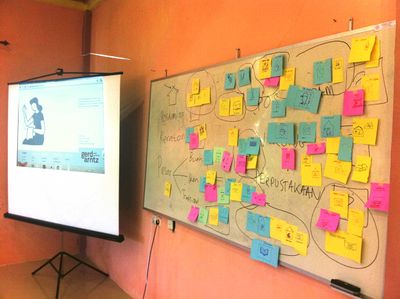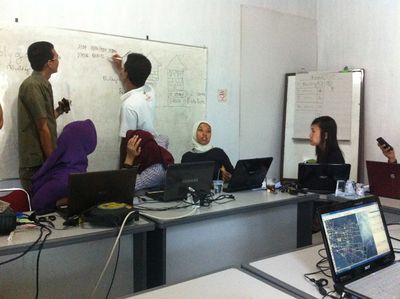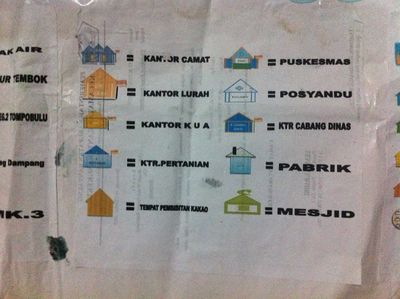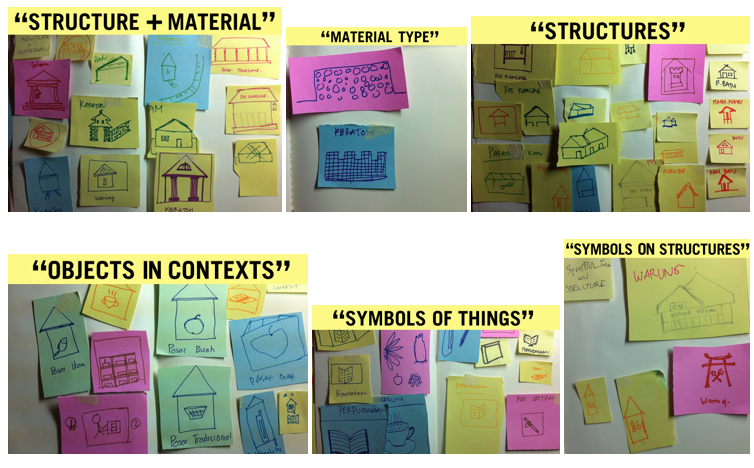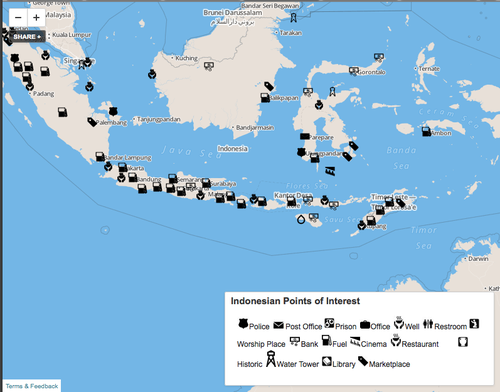Humanitarian OSM Tags Indonesia 2011
A summary of this HOT-ID project
We are developing new iconography for use in maps serving civil society in Indonesia. (See the Indonesia DRR page). The development of the icons is following a participatory design orientation, soliciting concepts from non-designer stakeholders and iteratively adjusting the symbology to meet demonstrated needs. During July we help workshops that explored design and internationalization issues in map iconography.
The goal of the HOT symbology design process: is to create a set of symbols corresponding to map features specific to common HOT-Indonesia activities. Our goal is not to replicate the complete list of OSM map features but rather to provide a specialized list of recommended feature tags which correspond to appropriately designed iconography for specific program implementation.
Reference taxonomy for discussion
This section describes the features that are actively of interest to HOT NGO mapping partners. The feature set emphasizes healthcare, educational and other village-level civic POIs.
- Building types:
- Atap (Roof Type:)
- Ilalang (Weed Roof)
- Seng / Asbes (Zinc/Asbestos Roof)
- Genteng (Tiled Roof)
- Dinding (Wall Type:)
- Bambu /Bedeg (Bamboo)
- Tembok Setengah (Half Wall)
- Tembok (Stone wall)
- Kayu / Papan (Wood / board)
- Lantai (Floor type:)
- Tanah (Ground / Soil)
- Papan (board)
- Plester / Semen (Cement)
- Tegel (Tekhel)
- Keramik (Ceramics)
- Bertingkat / Yidak (Terraced)
- Other Building features:
- Kepemilikan WC (Has latrine)
- Rumah Adat (Traditional House)
- Atap (Roof Type:)
- Kondisi Bangunan (Building Condition:)
- Sangat Miskin (Very Poor)
- Miskin (Poor / Bad Condition)
- Sedang (Medium / Mid-Condition)
- Kaya (Rich/ very good condition)
- Fasilitas pelayanan Kesehatan (Health facilities)
- PUSTU ( village Health center)
- Polindes / PoskesDes (Village health Pos)
- Tempat Praktek Bidan (midwife Pos)
- Puskesmas (Community Health center)
- Rumah Sakit (Hospital)
- Praktek Dokter Umum (General practice physician)
- Pos Obat desa (Postal village drug)
- Posyandu (Integrated Health Pos)
- Pratama (Primary)
- Madya (Medium)
- Purnama (Complete)
- Mandiri (Independent)
- Fasilitas Pendidikan (Educational POIs)
- PAUD/ Play Group / TK (Early education / Play group / Kindergarten)
- Sekolah Dasar (Primary schools)
- SLTP & Yang sederajat (Secondary schools)
- SLTA & Yang sederajat (High schools)
- Pendidikan Non-Formal (non formal educations)
- Pergurunan Tinggi (University)
- Perkantoran (Government Offices and Official POIs)
- Pos Polisi / Polsek (Police Station)
- Koramil (Military Post — Sub District level)
- Kantor Pos (Post Office)
- Kantor Kecamatan (Sub district office)
- kantor desa (Village Office)
- Kantor Bupati (District office)
- pendopo (Audience hall)
- Penjara (Jail)
- Fasilitasi Publik di desa (Civic POIs at the village level)
- Sumber Air (Water sources)
- WC Umum (Public restroom)
- MCK Umum (Public Bath and latrine)
- Sumur Bor (Artesian Well)
- Sumur Umum (Public well)
- Balai Desa / Tempat Pertemuan (Village hall)
- Tempat Ibadah (Places of whorship)
- Pasar Desa (Village market)
- Lembaga Keungan / Koperasi / ATM dst (Financial institution)
- Bak Penampung Air (Sump water)
- Makam / Kuburan (tomb)
- Pelelangan Ikan (Fish auction place)
- Dermaga / Penyeberangan (dock / crossing)
- Lapangan Oleh raga (Sport fields)
- Lapangan Sepak Bola (Soccer field)
- Lapangan Basket (basket ball court)
- Lapangan Voly (volley ball court)
- Lapangan Bulutangkis (Badminton court)
- Tennis Court
- Pos-Pos Keamanan (Security Pos)
- Pos Pengaduan warga / CC (Complaint center)
- Tempat Pembuangan Sampah (Landfill)
- Areal Bermain / Rekreasi (Playground / recreational place)
- Menara /Tiang / Tower
- Tempat pengisian bahan bakar (Refueling Place)
- Tempat hiburan / Bioskop / Sanggar (Place of entertainment / Movie)
- Perpustakaan Desa (Village libraries)
- Lapangan Pacuan Kuda (horse racing)
- Jembatan Sungai (Bridge)
- Sumber Air (Water sources)
- Batas Wilayah (Boundaries)
- Batas Dusun / Kampung (Boundary hamlet level)
- Batas Desa (boundary vilage level)
- Batas Kecamatan (Boundary sub district level)
- Batas kepemilikan tanah (boundary of land ownership)
- Lahan (Land)
- Lahan pertanian (Agriculture Land)
- Perkebunan (Plantation)
- Peternakan (animal husbandry land)
- Padang gembala (Plain)
- Perikanan /Tambak (Fishpond)
- Ladang garam (Salt Field)
- Areal Hutan (Forest area)
- hutan Lindung / Konservasi (Protected forest / Conservation)
- HTR (People forest plant)
- Subtropic forest
- HKM (Community forest Management)
- HTI (Industrial forest plantations)
- Hutan Keluarga (Family forest)
- Kagiatan Ekonomi (Economic Activities)
- Pangkalan Ojek (Motorcycle Taxis Base)
- Pasar Tradisional (Traditional market)
- Pangkalan kendaraan trandisional (Horse-drawn buggy base)
- Furniture Home Industries
- Industri Rumah Tangga (home Industries)
- Perbengkelan (Machine shop)
- Pengilingan Padi (rice huller)
- Pemecah Batu (Stone huler)
Indonesia Symbology Design Workshops in July 2011
Reference icons in use in Bantaeng partner offices
These were handmade by the NGO members for a map focused on poverty levels and land use.
Overview HOT Indonesia symbology development process:
- Icon brainstorming sessions (blog post)
- draft list design with first draft of some icons for discussion on the Talk-ID list and OSM wiki
- ongoing discussion and review of icons
- inclusion of the icon set in JSOM presets and OSM rendering
The icon design workshops have a simple participatory format:
- Talk about the history of icon design and discuss challenges in creating durable icons.
- Brainstorm numerous approaches to representing concepts and POIs with icons.
- Gather design ideas on post-its, then group them into a typology of styles.
- Publish the typology for discussion.
In the workshops, we proposed the following goals:
- The symbols must first make sense in Indonesia, without being overly idiomatic
- The symbols should prioritize structural vulnerability, but allow other POIs and concepts
- The symbols should be not rely exclusively on words, color or codes.
We brainstormed basic structural shapes:
- supports under a house
- roof angle and crennelations in a roofline
- large roof vs. small roof
- has doors and windows
- has two houses attached
- has traditional roofline
- has porch
- skinny supports indicate bamboo
- thick concrete pads indicate concrete foundation
- striped slats indicate wooden foundation
- thick flat walls suggest concrete blocks
- carved supports indicate wooden frame
- thatched roofing of palm vs flat angular tin
- textured walls made of palm leaf distinct from flat plaster and patterned masonry
- cracks indicating damaged masonry, wood,
- pillars suggesting reinforced masonry
- isometric 3-d used to indicate both leaning-frame structures, extra large structures
Result of the workshops and research
The icons developed with this process now live on a icon development page. We could not figure out how to batch upload to the wiki.
There is also a (github repository) that contains the full revision history of the tag set, and an archive of reference tags that were pulled from Tagstat and Taginfo.
![]() Screenshot of the icon development page.
Screenshot of the icon development page.
